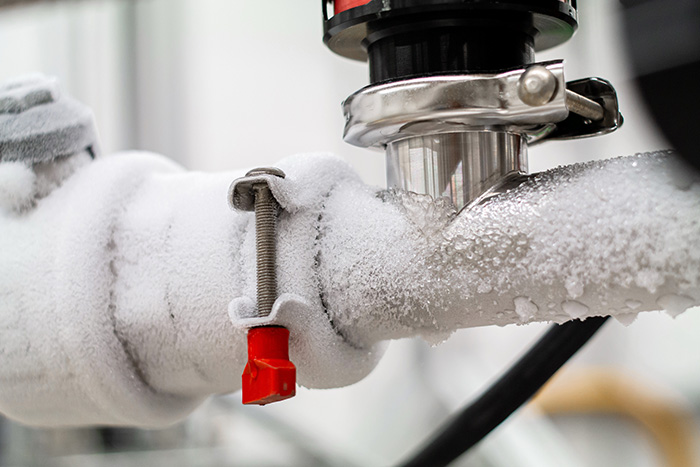Avoiding Frozen Plumbing in Winter: Key Strategies
Avoiding Frozen Plumbing in Winter: Key Strategies
Blog Article
The article listed below about Helpful Tips to Prevent Frozen Pipes this Winter is without a doubt entertaining. Read it for yourself and decide what you think about it.

Winter can damage your pipes, especially by freezing pipes. Below's exactly how to prevent it from happening and what to do if it does.
Intro
As temperatures drop, the threat of frozen pipelines increases, potentially resulting in pricey repair services and water damage. Comprehending how to avoid icy pipes is crucial for property owners in cool climates.
Comprehending Icy Pipes
What triggers pipelines to freeze?
Pipelines freeze when subjected to temperatures listed below 32 ° F (0 ° C) for extended durations. As water inside the pipelines freezes, it expands, putting pressure on the pipe walls and potentially causing them to burst.
Risks and damages
Frozen pipelines can bring about water system disturbances, home damages, and pricey repair services. Ruptured pipes can flooding homes and create extensive structural damages.
Indications of Frozen Water Lines
Recognizing frozen pipelines early can stop them from bursting.
Just how to determine icy pipes
Seek reduced water circulation from taps, unusual smells or noises from pipelines, and visible frost on revealed pipes.
Avoidance Tips
Insulating prone pipelines
Wrap pipes in insulation sleeves or make use of warm tape to shield them from freezing temperature levels. Concentrate on pipelines in unheated or external locations of the home.
Heating techniques
Keep interior areas adequately heated, especially areas with plumbing. Open up closet doors to enable warm air to flow around pipes under sinks.
Protecting Exterior Plumbing
Garden hoses and exterior taps
Detach and drain garden tubes before wintertime. Install frost-proof faucets or cover outside faucets with shielded caps.
What to Do If Your Pipelines Freeze
Immediate activities to take
If you presume frozen pipes, keep taps open up to soothe pressure as the ice thaws. Utilize a hairdryer or towels soaked in warm water to thaw pipes slowly.
Long-Term Solutions
Architectural adjustments
Take into consideration rerouting pipes away from outside wall surfaces or unheated locations. Include additional insulation to attic rooms, cellars, and crawl spaces.
Updating insulation
Buy top quality insulation for pipelines, attic rooms, and wall surfaces. Correct insulation helps maintain constant temperature levels and lowers the risk of icy pipelines.
Verdict
Preventing icy pipes calls for positive procedures and quick reactions. By understanding the reasons, signs, and preventive measures, homeowners can shield their plumbing throughout winter.
6 Proven Ways to Prevent Frozen Pipes and Protect Your Home
Disconnect and Drain Garden Hoses
Before winter arrives, start by disconnecting your garden hoses and draining any remaining water. Close the shut-off valves that supply outdoor hose bibs and leave the outdoor faucet open to allow any residual water to drain. For extra protection, consider using faucet covers throughout the colder months. It’s also important to drain water from any sprinkler supply lines following the manufacturer’s directions.
Insulate Exposed Pipes
Insulating your pipes is an effective way to prevent freezing. Pipe insulation is readily available at home improvement stores and is relatively inexpensive. Pay close attention to pipes in unheated areas such as the attic, basement, crawl spaces, or garage. Apply foam insulation generously to create a buffer against the cold. You can also wrap your pipes in heat tape or thermostat-controlled heat cables for added warmth.
Seal Air Leaks
Inspect your home for any cracks or openings that could let in cold air. Seal any holes around the piping in interior or exterior walls, as well as the sill plates where your home rests on its foundation. Additionally, make sure to keep your garage door closed unless you’re entering or exiting. Leaving it open creates a significant air leak that can lead to frozen pipes.
Allow Warm Air Circulation
During cold snaps, it’s essential to allow warm air to circulate evenly throughout your home. Leave interior doors ajar to promote better airflow. Open kitchen and bathroom cabinets to help distribute heat consistently around the rooms. If you have small children or pets, be sure to remove any household chemicals or potentially harmful cleaners from open cabinets for safety.
Let Faucets Drip
A small trickle of water can make a big difference in preventing ice formation inside your pipes. When temperatures drop significantly, start a drip of water from all faucets served by exposed pipes. This continuous flow helps prevent the water from freezing. Additionally, running a few faucets slightly can relieve pressure inside the pipes, reducing the chances of a rupture if the water inside does freeze.
https://choateshvac.com/6-proven-ways-to-prevent-frozen-pipes-and-protect-your-home/

As an avid person who reads on How to Prevent Your Pipes From Freezing, I was thinking sharing that piece of content was a smart idea. Be sure to take the time to share this blog if you liked it. We love your readership.
Call Today Report this page